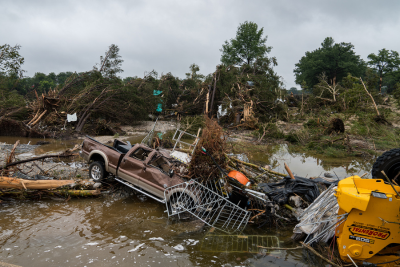Unfounded rumors linking an extreme weather event to human efforts to control the weather are again spreading on social media. It’s not plausible that available weather modification techniques caused or influenced the July 4 flash flooding along the Guadalupe River in Texas.
The flooding, which is known to have killed at least 134 people, including at least 37 children, as of July 15, occurred after remnants of a tropical storm moved north and stalled over a region known as “Flash Flood Alley” that is prone to flash flooding due to its terrain. Experts have said that climate change likely played a role in worsening the rain.
However, popular social media posts implied without evidence that the Texas flooding resulted from attempts to modify the weather. Some posts, including ones amplified by former Trump national security adviser and retired Lt. Gen. Michael Flynn, made an unfounded suggestion that cloud seeding by a particular company may have caused the flooding.
“This isn’t just bad weather,” read one post. “It looks a hell of a lot like weather warfare.”

Cloud seeding is a real weather modification method, often used in an attempt to alleviate drought, that can sometimes nudge clouds to produce small amounts of rain or snow. It does not cause rain at the scale seen in the Texas flooding.
Cloud seeding “had no influence on the outcome of the July 4th flooding,” Katja Friedrich of the University of Colorado Boulder’s Department of Atmospheric and Oceanic Sciences told us in an email, basing her comments on her own past research on the subject.
“I love how confident people are in science but if cloud seeding would work as they often think, we would probably be able to solve the water crisis in the western US or in other arid regions but we are not able to do so,” she added.
In contrast, climate change caused by heat-trapping pollution, in large part due to the burning of fossil fuels, is known to increase extreme rainfall events. “It is pretty clear that climate change increased rainfall” in Texas, Michael Wehner, a senior scientist at the Lawrence Berkeley National Laboratory, told us via email. It’s more difficult, he said, to say what role climate change played in how high or how quickly the water levels rose, since this requires modeling taking into account complex local factors.
We previously wrote about conspiracy theories — fueled by Rep. Marjorie Taylor Greene, a Republican from Georgia — that someone deliberately caused or steered Hurricane Helene in 2024 via weather modification. It is not possible to cause or steer a hurricane. On July 5, Greene announced new legislation to restrict weather modification. Florida, Tennessee and Louisiana have enacted or are set to enact laws curtailing weather modification.
In July 5 posts on X and Substack, Kandiss Taylor, a Republican candidate for Congress from Georgia, also pushed the idea of “fake” and “manufactured” extreme weather. Taylor suggested that Hurricane Helene, which she said personally cost her family $57,000 in damages, was the result of weather modification, or “targeted destruction,” as she put it, and other disasters might be as well.
“If storms are being manipulated, and people die because of it, that’s not just tragedy,” she wrote. “That’s murder.”
Taylor told us via email that her posts were “in response to proposed new legislation in congress not about Texas. The media twisted what I posted.” But in her Substack and elsewhere, she suggested the Texas flooding could be due to weather manipulation. “Now, I’m watching in nonstop prayer what’s happening in Texas. And let me tell you, the patterns, the timing, the scale raises serious questions,” she wrote on Substack.
Unfounded Claims About Cloud Seeding
Cloud seeding relies on releasing small particles, most often silver iodide crystals, into clouds, which can help raindrops or ice crystals form from existing moisture and fall from the sky. As of July 2024, there were active cloud seeding projects in nine states, including Texas, according to a report from the Government Accountability Office.
Many social media posts have suggested that Rainmaker Technology Corporation may have caused the flooding. The company performed cloud seeding on July 2 in Karnes County, Texas, several counties southeast from where the flooding took place.
But it’s not plausible the company’s activities played a role in the Texas flooding, experts told us and other news outlets.
For one thing, the cloud seeding in Karnes County happened too far in advance of the storm to be relevant at all, Friedrich told us, explaining that her team’s research has shown that “cloud seeding material usually stays in the atmosphere for 2-4 hours depending on wind speed and conditions.”
If the cloud seeding happened on July 2, there was “no way that material was still in the atmosphere” by the time of the storm, Friedrich said. Thunderstorms, of course, are also able to produce large amounts of rainfall on their own, she said, adding that there is “no need for cloud seeding.”
Indeed, Rainmaker’s CEO, Augustus Doricko, responded to Flynn on X, writing that the two “clouds that were seeded on July 2nd dissipated over 24 hours prior to the developing storm complex that would produce the flooding rainfall.”
But even if cloud seeding had happened closer to the relevant storm, experts said, it would not have caused the extreme amount of rain that fell.
Friedrich said that her team’s past work showed that “cloud seeding produces rather small amounts of precipitation” — on the order of fractions of a millimeter of snow. In fact, a challenge in quantifying the results of cloud seeding, she said, has been that the amount of precipitation “is so small and often much smaller than natural precipitation.”

During the Texas flooding, the Guadalupe River rose 26 feet in 45 minutes at Hunt, Texas, and 2 to 3 inches of rain fell each hour at times, a National Weather Service spokesperson previously told us.
“The amount of energy involved in making storms like that is astronomical compared to anything you can do with cloud seeding,” Bob Rauber, an atmospheric scientist and emeritus professor at the University of Illinois Urbana-Champaign, similarly told the Washington Post. “We’re talking about a very small increase on a natural process at best.”
Furthermore, as we’ve said, the slow movement of the storm helped cause the flooding. “Cloud seeding influences how cloud particles grow but not the movement or stalling of thunderstorms,” Friedrich said.
Climate Change Likely Increased Rainfall
As we’ve said, multiple natural factors conspired to cause the flooding. But experts said that climate change likely did increase the rain.
Texas State Climatologist John Nielsen-Gammon, who is also director of the Southern Regional Climate Center and a professor at Texas A&M University, agreed via email that climate change likely increased total rainfall.
He explained that warmer air can carry more water vapor and can “produce larger rainfall rates.” Another factor influencing the severity of the flooding was the short amount of time it took for a large amount of rain to fall. “There’s evidence that shorter-duration extreme rainfall is intensifying more rapidly than longer-duration extreme rainfall, so maybe storms themselves are becoming more concentrated,” he said.
ClimaMeter, an international project to rapidly interpret the relationship between extreme weather and climate, compared conditions in the past with those in more recent decades, finding that conditions in parts of central Texas were 7% wetter in the years since 1987 than between 1950 and 1986. However, the scientists said they had “low confidence in the robustness of our approach,” given the available data and the exceptionality of the flooding. The group concluded that the heavy rain was “locally intensified by human-driven climate change.”
Wehner informally estimated that climate change likely increased rainfall by at least 7%, based simply on the increase in water vapor in the air caused by warming in the Gulf. After taking into account factors associated with the “extra available energy in warmer temperatures,” he said, he came up with a possible 20% increase in rainfall. Wehner has done formal attribution studies in the past for extreme weather events, which he said his calculations did not replace, but he told us he wouldn’t be doing one for this event.
Editor’s note: FactCheck.org does not accept advertising. We rely on grants and individual donations from people like you. Please consider a donation. Credit card donations may be made through our “Donate” page. If you prefer to give by check, send to: FactCheck.org, Annenberg Public Policy Center, P.O. Box 58100, Philadelphia, PA 19102.